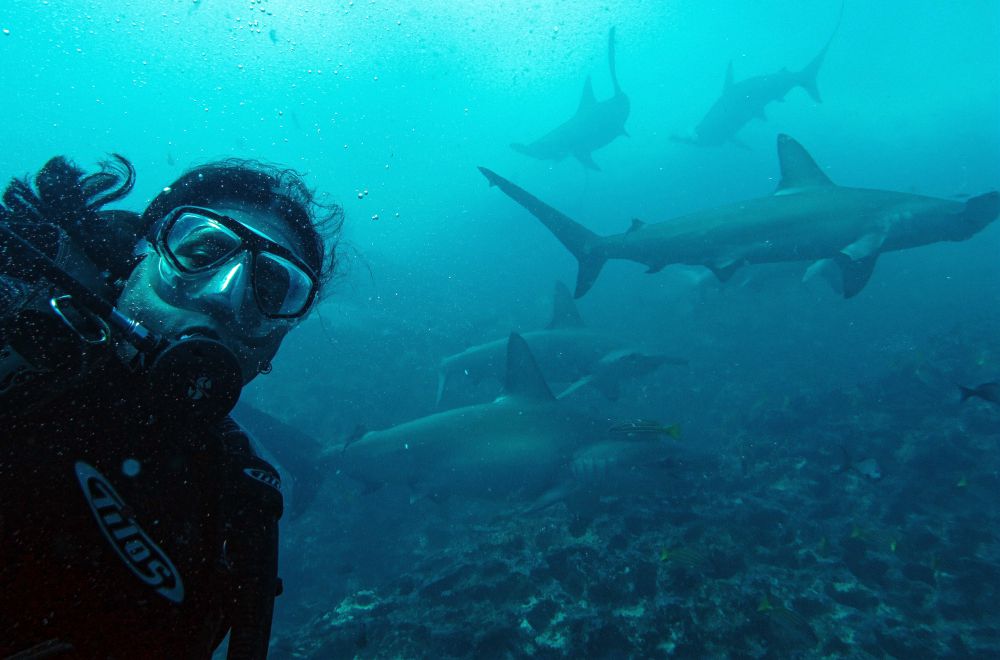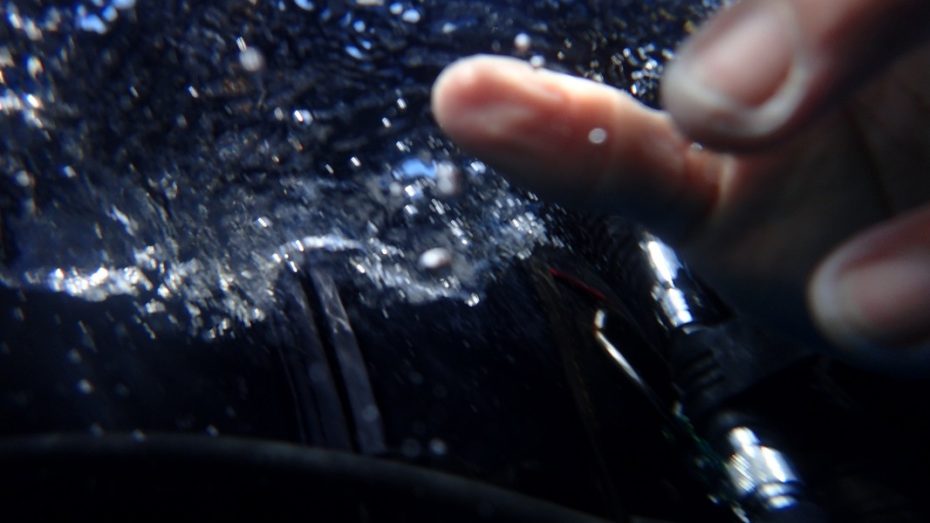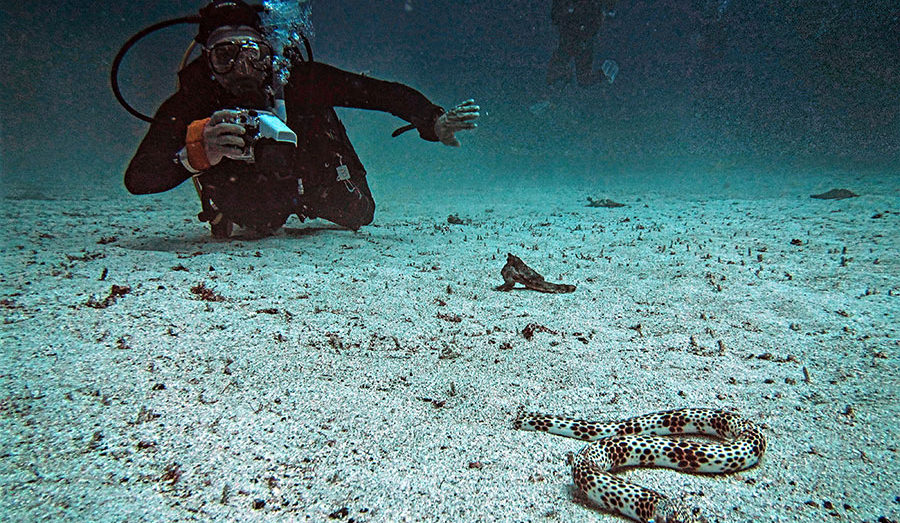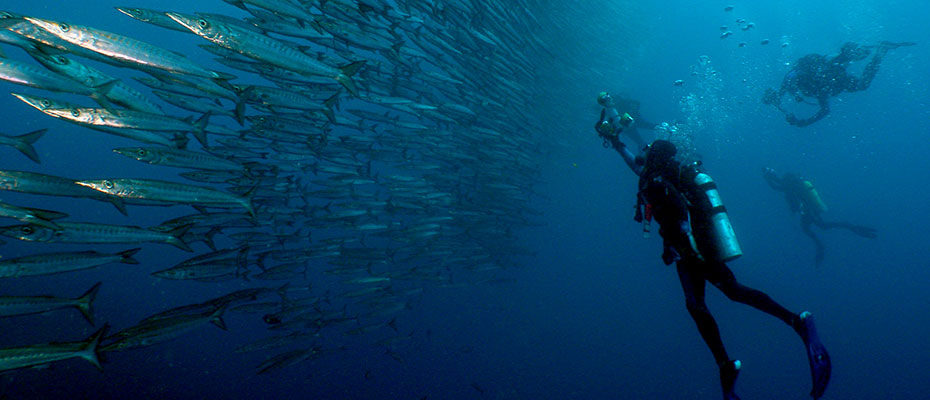Are you new to the world of diving? Are you excited to start recording your underwater adventures with your GoPro? It’s totally understandable. Everyone at Academy Bay, and all divers around the world, share the same passion for exploring stunning sights and species.
However, if you’re especially inexperienced, you should consider mastering the basics before trying to record your experiences. In this blog, I’ll explain why.
Scroll down to find out more! And if you have any questions about our Galapagos diving trips and courses, please contact us.

Getting to know the Hammerhead Sharks
Beginner Divers and Cameras Do Not Mix
Taking pictures and videos underwater is a passion for many divers, and getting ‘that’ photo can be a bit of an obsession. This is especially true in a place as special as the Galapagos Islands. With the introduction of the GoPro, we have seen a huge increase in the number of divers who have their own underwater cameras, and unfortunately, also an increase in terrible beginner and intermediate divers!
Many people already have GoPros before they learn to dive, so the natural progression is to take it underwater, whilst many new divers rush out to buy the camera as soon as they are certified.
This, we believe, is a big mistake.
New divers must first learn how to breathe underwater, have neutral buoyancy, and have self-awareness in the water before even thinking about an underwater camera, but we are seeing this is not the case.
Maybe new students are not being advised by their instructors about using cameras before they are ready, or maybe they are ignoring the advice, but we are seeing more and more new divers — and I mean with 4 to 20 dives in their logbooks — wanting to dive with their camera.
I can speak from personal experience. I love taking photos and videos. I have around 200 dives, and still, when I get a camera in my hand, I find it very easy to forget about everything. The most worrying factors are my buoyancy and the rest of the group or my buddy. It is so easy to focus on the subject of your photo or video and find yourself 10 meters deeper in seconds, or you finally get the angle you want and look up to find, oops, you are all alone with no idea about where the group has gone.
With 200 dives, if either of these things happens to me, I can either find the group again quickly or surface on my own. But if you had 4 dives or 6 dives, would you be so calm? Would you know what to do?

Factors for New Divers to Consider When Diving with a Camera
Apart from your personal safety, you should also keep these other factors in mind if you’re a new diver entering the water with a camera:
Other Divers: New divers with cameras frequently bump into, kick, knock, and generally get in the way of other divers. This does not make for a happy surface interval.
The Reef: New divers with cameras do not have good, if any, buoyancy control and bounce up and down off the bottom, off the reef, off the rocks. This is not good for the environment you are diving in and can result in you being banned from the next dive in some places. The dive companies here have to follow park rules and look after the areas they dive, so if you don´t follow the rules, you are out, whether you have paid for more than one dive or not.
Rental Dive Equipment: The same as above. Bouncing onto the bottom, rocks, and the reef isn’t good for our equipment. Most dive centers require you to pay for any equipment damage they deem preventable.
The Photos You are Taking: Sorry to break it to you, but they will probably be terrible. If you do not have good buoyancy, your videos will be all over the place and your photos will probably only have half the subject matter in them. You may look back and wish you had spent more time admiring the incredible marine life of the Galapagos in the moment.

What to Expect on Our Galapagos Dive Trips
Our policy at Academy Bay Diving is: if you have 20 dives or less, you can’t take your camera, and if you have more than 20 dives and don’t do well on the first dive with your camera, you will be asked to leave it on the boat.
The guides leading our Galapagos diving trips take a small camera and take photos and videos of you and the animals. I can guarantee, if you are a new diver, their photos and videos will be better than yours.
So, learn how to breathe underwater, how to use your equipment, and practice your buoyancy. Then and only then, take your camera diving. It is not that hard to dive, but it can be quite difficult and take a lot of practice to be a good diver with good buoyancy.
If you are asked not to dive with your camera please don’t get angry. The guides are not trying to insult you, they are trying to make it an enjoyable dive for the whole group, whilst looking after the marine environment you have come to see.
Do you have any questions for the Academy Bay Diving team? Please feel free to contact us for all the answers you need.










